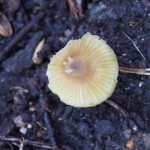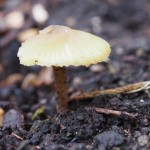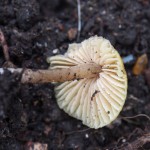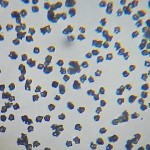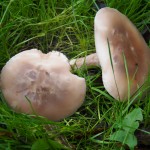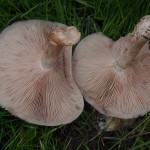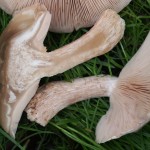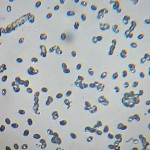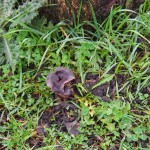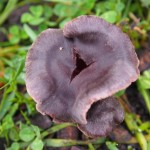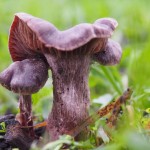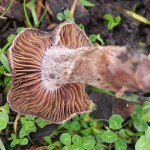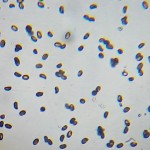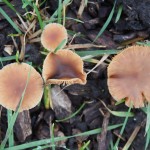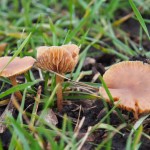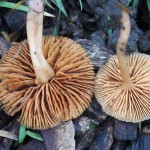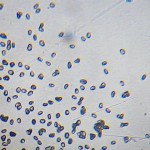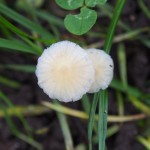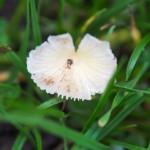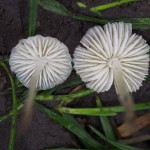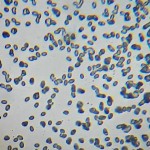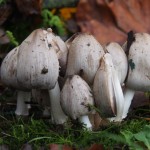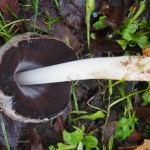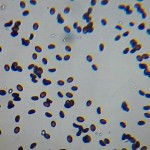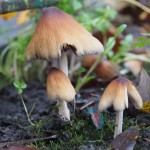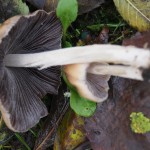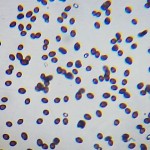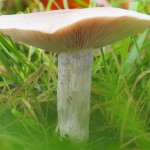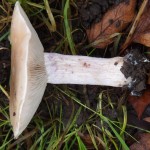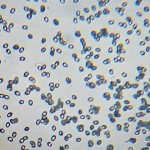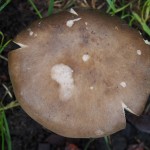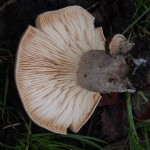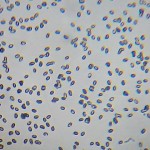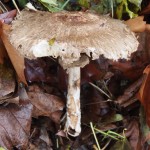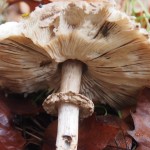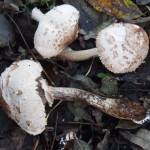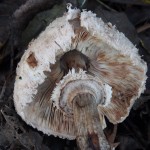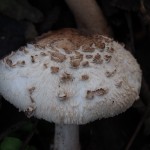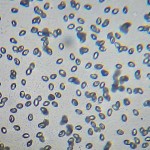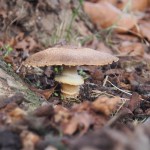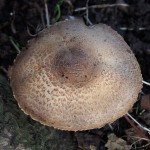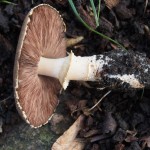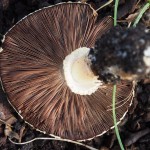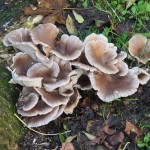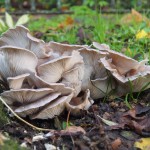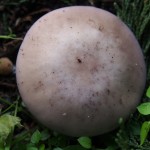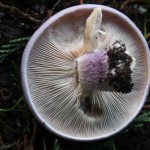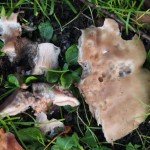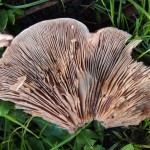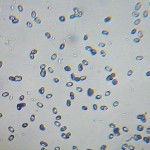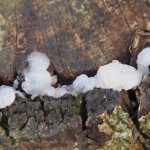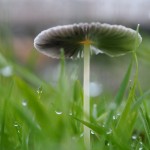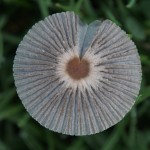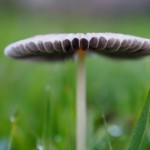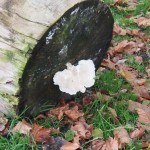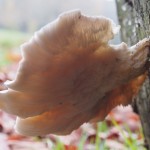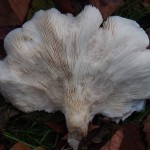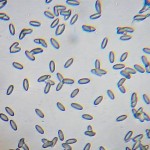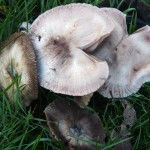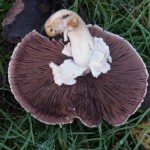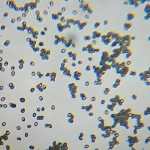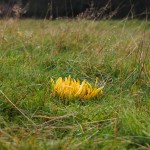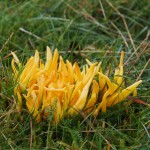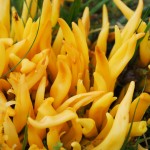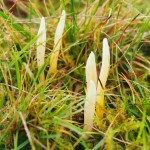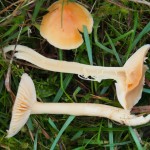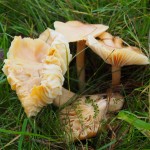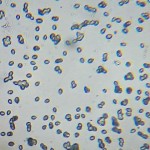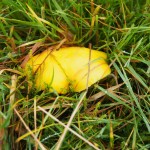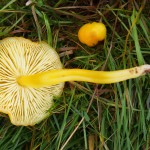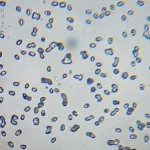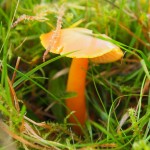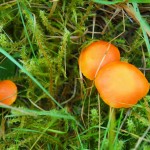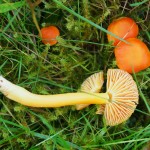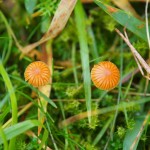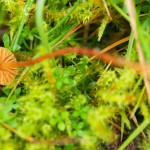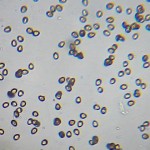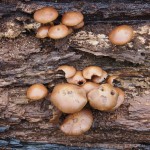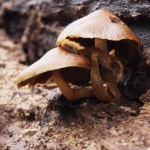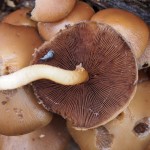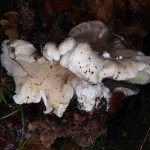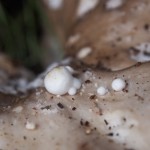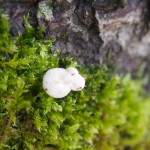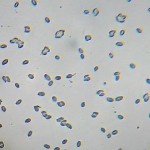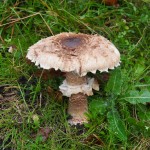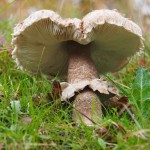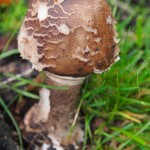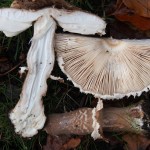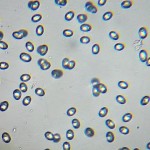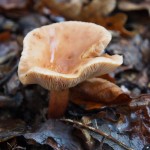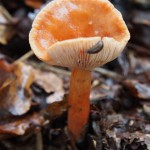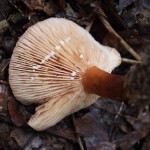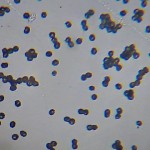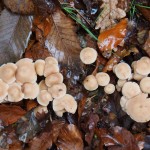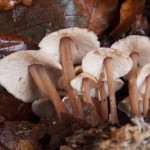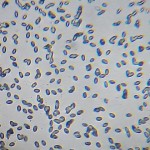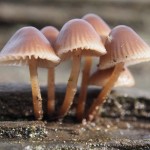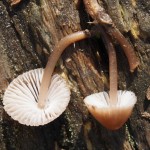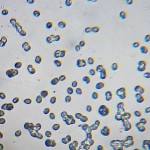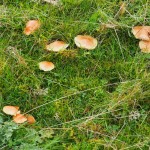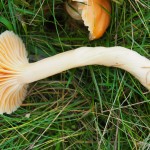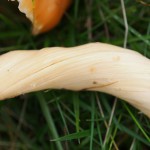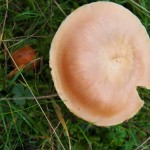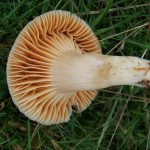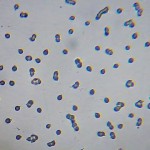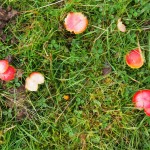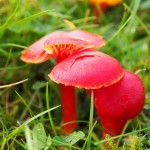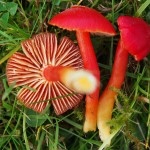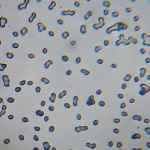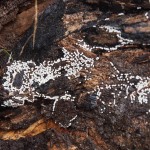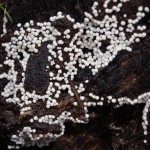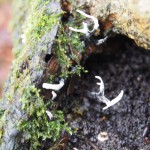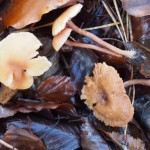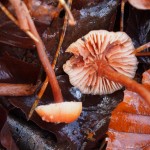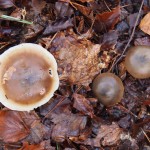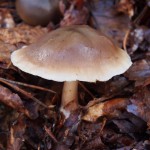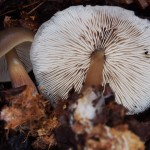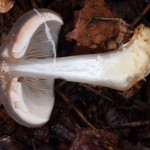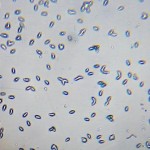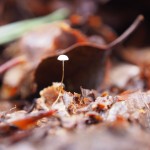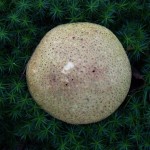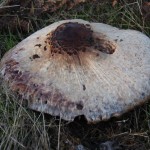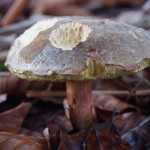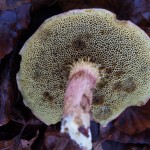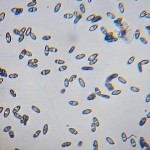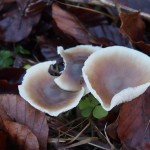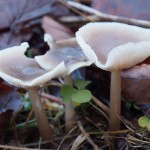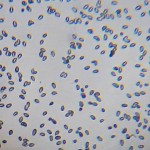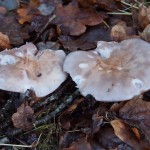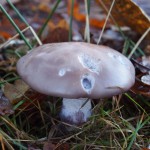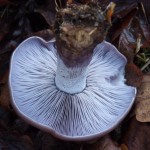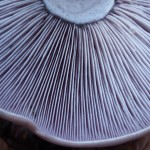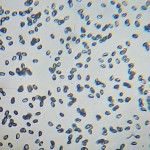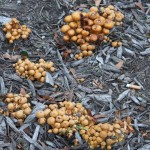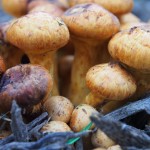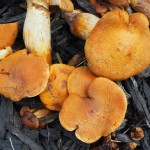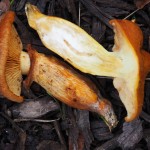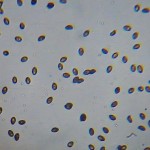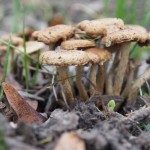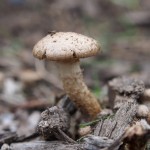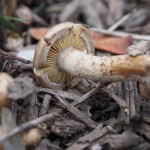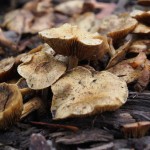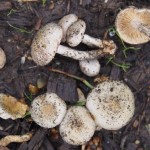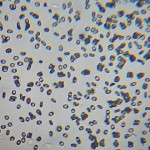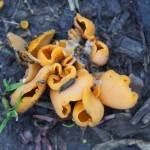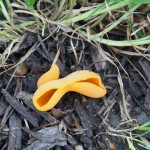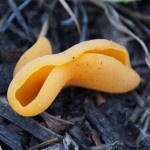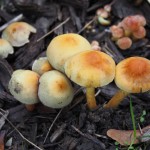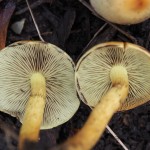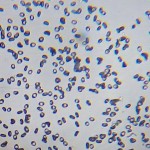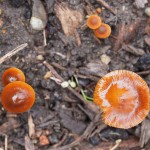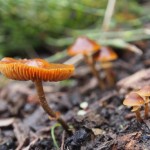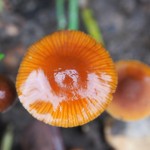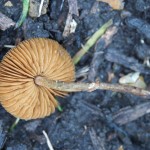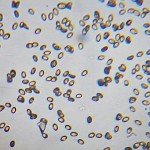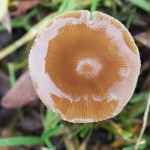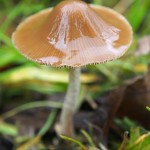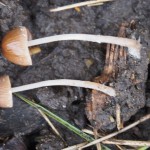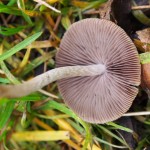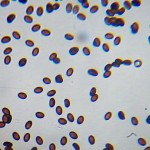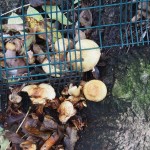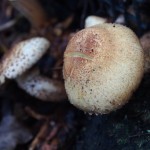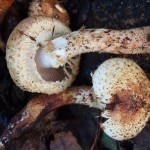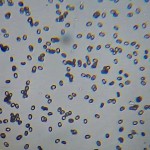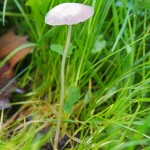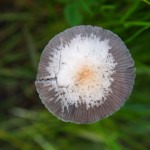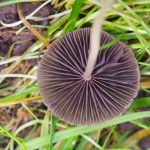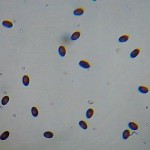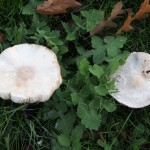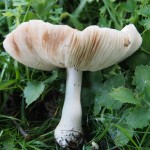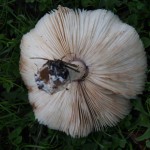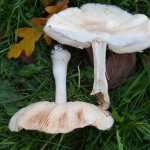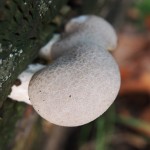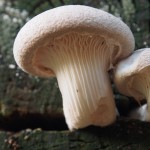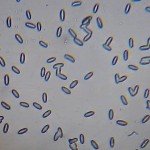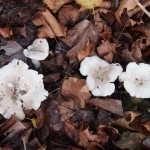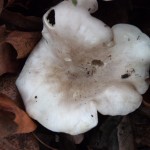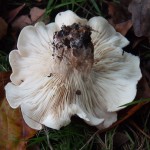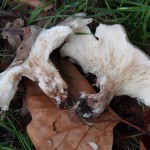Just a small brownish mushroom growing in my garden, but it is a species that I’ve not found before: Aromatic Pinkgill (Entoloma pleopodium)… these things just pop up, one or two of them, and then are gone. This looked like a fairly boring species of Bonnet until I saw the spores under a microscope – almost star-shaped, but certainly angular and spikey. This seems to be a characteristic of the Entoloma genera, and I’ve not found so many of these recently. So I looked for fungi with star shaped spores and although there’s quite a few, that was enough get me to an identification very quickly.
Monthly Archives: November 2014
1. Aromatic Pinkgill (Entoloma pleopodium).
- 1. Aromatic Pinkgill
- 1. Aromatic Pinkgill
- 1. Aromatic Pinkgill
- 1. Aromatic Pinkgill
27th November 2014, Ladywell Fields
Lots more mushrooms in Ladywell Fields…
I have been looking for Field Blewits for 30 years and now I’ve found them in the local park! My mushroom adventures started with a find of Field Blewits at Warwick University, and they’re so distinctive that despite my total ignorance (at the time) I was able to identify and consume them. (The lilac stipe and perfumed smell are all you need.) So I’ve always been on lookout for some more, but nothing until now, even though they’re supposed to be common. Great to eat, and so I did.
Also some more Flowery Blewits. Almost identical to the Field Blewits apart from the absence of lilac colouring. I’m not absolutely certain of my identification here – Roger Phillips says they’re uncommon and does a patch of grass on the edge of Ladywell Fields with one or two trees count as ‘open woodland’?
I occasionally see Common Inkcaps but this is the first time I’ve managed to photograph them. And the other interesting find was a Parasol Mushroom. Quite impressive, one of my favourites, and very common, but again not something I was expecting to find in the park. This is another species that stirred my interest many years ago, when I found a colony growing in a pine wood in Hampshire.
1. Flowery Blewit (Lepista irina).
- 1. Flowery Blewit
- 1. Flowery Blewit
- 1. Flowery Blewit
- 1. Flowery Blewit
2. Unidentified.
- 2. Unidentified
- 2. Unidentified
- 2. Unidentified
- 2. Unidentified
- 2. Unidentified
3. Unidentified.
- 3. Unidentified
- 3. Unidentified
- 3. Unidentified
- 3. Unidentified
4. Ivory Bonnet (Mycena flavoalba).
- 4. Ivory Bonnet
- 4. Ivory Bonnet
- 4. Ivory Bonnet
- 4. Ivory Bonnet
5. Common Inkcap (Coprinus atramentarius).
- 5. Common Inkcap
- 5. Common Inkcap
- 5. Common Inkcap
6. Unidentified.
- 6. Unidentified
- 6. Unidentified
- 6. Unidentified
7. Field Blewit (Lepista saeva).
- 7. Field Blewit
- 7. Field Blewit
- 7. Field Blewit
- 7. Field Blewit
8. Unidentified.
- 8. Unidentified
- 8. Unidentified
- 8. Unidentified
- 8. Unidentified
9. Parasol (Macrolepiota procera).
- 9. Parasol
- 9. Parasol
10. Macrolepiota rhacodes.
- 10. Macrolepiota rhacodes
- 10. Macrolepiota rhacodes
- 10. Macrolepiota rhacodes
- 10. Macrolepiota rhacodes
20th November 2014, Ladywell Fields
Nice to find some Wood Blewits in the park – they’re very common but I’ve only found them in woods proper before, not parkland. I tucked into these.
I went back to look at a Branching Oyster which was very immature when I saw it on the 5th – 2 weeks ago. But this time I got a spore sample and realised that it must be a Veiled Oyster instead! The pictures in my books don’t fit so well, but I’m fairly sure after doing some further investigation of pictures on the web. The young specimens from earlier are particularly distinctive, although lacking the ring zone. Also the habit of growing from cracks/holes is distinctive of this species. I ate this, believing it to be a Branching Oyster. Collins Fungi Guide/Buczacki doesn’t specifically say if it’s edible but other Oysters are, and it didn’t do me any harm. Very nice it was too – firm and almost crunchy.
Actually I regret not eating The Prince as well – it’s very, very tasty. I’ve been seeing Prince-like mushrooms around in the park for a while and so had my doubts about definite identification, but this one is definitely a Prince.
1. The Prince (Agaricus augustus).
- 1. The Prince
- 1. The Prince
- 1. The Prince
- 1. The Prince
- 1. The Prince
2. Oyster Mushroom (Pleurotus ostreatus).
- 2. Oyster Mushroom
- 2. Oyster Mushroom
3. Wood Blewit (Lepista nuda).
- 3. Wood Blewit
- 3. Wood Blewit
- 3. Wood Blewit
- 3. Wood Blewit
- 3. Wood Blewit
4. Unidentified.
- 4. Unidentified
5. Parasola auricoma.
- 5. Parasola auricoma
- 5. Parasola auricoma
- 5. Parasola auricoma
- 5. Parasola auricoma
6. Veiled Oyster (Pleurotus dryinus).
- 6. Veiled Oyster
- 6. Veiled Oyster
- 6. Veiled Oyster
- 6. Veiled Oyster
- 6. Veiled Oyster
7. Yellow Stainer (Agaricus xanthodermus).
- 7. Yellow Stainer
- 7. Yellow Stainer
- 7. Yellow Stainer
14th November 2014, Knole Park, Sevenoaks
Knole Park was fungally fabulous two months ago so I decided to go back. Actually I’m exaggerating – it was only pretty good last time, but it’s easy to get to and has a variety of unimproved habitats, which is what the fungi folk generally prefer. I’m turning into a fungus species ticker – 9 new species registered on this foray!
I walked through the gate to the nearest patch of grass and immediately found a large sprouting of Golden Spindles and various Waxcaps. The Spindles were very striking, and not something I’ve ever seen before, so I wasn’t sure at first whether it was a fungus at all or some kind of plant! I also saw some Rose Spindles but didn’t even take a picture – at the time I thought it was a variant colour of the species that I did record. There were many types of Waxcap, and again I’m not so familiar with this genus, so I got a bit overwhelmed and certainly missed a few. With a bit of guesswork I think that I found Honey Waxcap, Golden Waxcap, Meadow Waxcap and Vermillion Waxcap, although some of these are easy to confuse with each other.
Another point of interest was the possible small fungus growing on an old Oyster Mushroom. It was tiny, and I should have kept a specimen to examine under a magnifying glass, as now I’m not sure whether it really was a mushroom. The Shaggy Parasol was a fine photogenic specimen indeed, and the large old decrepit Parasol was the biggest I’ve ever seen – shame I wasn’t there to witness its full glory.
1. Golden Spindles (Clavulinopsis fusiformis).
- 1. Golden Spindles
- 1. Golden Spindles
- 1. Golden Spindles
2. Yellow Club (Clavulinopsis helvola).
- 2. Yellow Club
3. Honey Waxcap (Hygrocybe reidii).
- 3. Honey Waxcap
- 3. Honey Waxcap
- 3. Honey Waxcap
- 3. Honey Waxcap
4. Golden Waxcap (Hygrocybe chlorophana).
- 4. Golden Waxcap
- 4. Golden Waxcap
- 4. Golden Waxcap
5. Vermillion Waxcap (Hygrocybe miniata).
- 5. Vermillion Waxcap
- 5. Vermillion Waxcap
- 5. Vermillion Waxcap
6. Orange Bonnet (Mycena acicula).
- 6. Orange Bonnet
- 6. Orange Bonnet
- 6. Orange Bonnet
7. Common Stump Brittlestem (Psathyrella piluliformis).
- 7. Common Stump Brittlestem
- 7. Common Stump Brittlestem
- 7. Common Stump Brittlestem
- 7. Common Stump Brittlestem
8. Oyster Mushroom (Pleurotus ostreatus).
- 8. Oyster Mushroom
- 8. Oyster Mushroom
- 8. Oyster Mushroom
- 8. Oyster Mushroom
9. Shaggy Parasol (Macrolepiota rhacodes).
- 9. Shaggy Parasol
- 9. Shaggy Parasol
- 9. Shaggy Parasol
- 9. Shaggy Parasol
- 9. Shaggy Parasol
10. Mild Milkcap (Lactarius subdulcis).
- 10. Mild Milkcap
- 10. Mild Milkcap
- 10. Mild Milkcap
- 10. Mild Milkcap
11. Russet Toughshank (Collybia dryophila).
- 11. Russet Toughshank
- 11. Russet Toughshank
- 11. Russet Toughshank
- 11. Russet Toughshank
12. Clustered Bonnet (Mycena inclinata).
- 12. Clustered Bonnet
- 12. Clustered Bonnet
- 12. Clustered Bonnet
13. Meadow Waxcap (Hygrocybe pratensis).
- 13. Meadow Waxcap
- 13. Meadow Waxcap
- 13. Meadow Waxcap
- 13. Meadow Waxcap
- 13. Meadow Waxcap
- 13. Meadow Waxcap
- 13. Meadow Waxcap
14. Scarlet Waxcap (Hygrocybe coccinea).
- 14. Scarlet Waxcap
- 14. Scarlet Waxcap
- 14. Scarlet Waxcap
- 14. Scarlet Waxcap
15. Unidentified.
- 15. Unidentified
- 15. Unidentified
16. Candlesnuff Fungus (Xylaria hypoxylon).
- 16. Candlesnuff Fungus
17. The Deceiver (Laccaria laccata).
- 17. The Deceiver
- 17. The Deceiver
- 17. The Deceiver
18. Butter Cap (Collybia butyracea).
- 18. Butter Cap
- 18. Butter Cap
- 18. Butter Cap
- 18. Butter Cap
- 18. Butter Cap
19. Dripping Bonnet (Mycena rorida).
- 19. Dripping Bonnet
20. Common Earthball (Scleroderma citrinum).
- 20. Common Earthball
21. Parasol (Macrolepiota procera).
- 21. Parasol
22. Red Cracking Bolete (Boletus chrysenteron).
- 22. Red Cracking Bolete
- 22. Red Cracking Bolete
- 22. Red Cracking Bolete
23. Butter Cap (Collybia butyracea).
- 23. Butter Cap
- 23. Butter Cap
- 23. Butter Cap
24. Wood Blewit (Lepista nuda).
- 24. Wood Blewit
- 24. Wood Blewit
- 24. Wood Blewit
- 24. Wood Blewit
- 24. Wood Blewit
8th November 2014, Ladywell Fields
Next to the path that runs beside Ladywell Stadium there was an Ash tree growing, but then last year it was cut down and stump grinded. Now the site has a mass of wood fragments buried in the earth and scattered over it. The fungi love it! I found 7 different species all within 2 metres of each other. One of them was too immature to identify but the others I’ve recorded, although some are difficult to identify. Sulphur Tuft seems to me the commonest mushroom in Britain and I must have seen it in the park before but didn’t record it until now. Orange Peel Fungus is a nice find and quite striking. Not sure about the possible Galerina nana – it looks about right but the spore size is wrong. Is there something wrong with my spore measurement techniques (I don’t think so), or have I mixed up some specimens (more likely), or is it a species not listed in my book (fairly unlikely). The book in question is Collins Fungi Guide (Buczacki) – “the most complete field guide to the mushroom and toadstools of Britain and Ireland”.
1. Spectacular Rustgill (Gymnopilus junonius).
- 1. Spectacular Rustgill
- 1. Spectacular Rustgill
- 1. Spectacular Rustgill
- 1. Spectacular Rustgill
- 1. Spectacular Rustgill
2. Sticky Scalycap (Pholiota gummosa).
- 2. Sticky Scalycap
- 2. Sticky Scalycap
- 2. Sticky Scalycap
- 2. Sticky Scalycap
- 2. Sticky Scalycap
- 2. Sticky Scalycap
3. Orange Peel Fungus (Aleuria aurantia).
- 3. Orange Peel Fungus
- 3. Orange Peel Fungus
- 3. Orange Peel Fungus
4. Sulphur Tuft (Hypholoma fasciculare).
- 4. Sulphur Tuft
- 4. Sulphur Tuft
- 4. Sulphur Tuft
5. Galerina nana.
- 5. Galerina nana
- 5. Galerina nana
- 5. Galerina nana
- 5. Galerina nana
- 5. Galerina nana
6. Unidentified.
- 6. Unidentified
- 6. Unidentified
- 6. Unidentified
- 6. Unidentified
- 6. Unidentified
5th November 2014, Ladywell Fields
It seems that the mushroom season is going prolong well into November this year, with the mild weather. I didn’t expect to find very much, and I only had an hour before the light failed, but there were still a few finds. The Shaggy Scalycap is common in Ladywell (and everywhere!) but these specimens were larger than I’ve usually seen. The immature Veiled Oyster is very nice, except I thought it was a Branching Oyster until I sorted out my spore samples, which I had mixed up initially. Clouded Funnel is very common, but I haven’t found it in the park before.
1. Shaggy Scalycap (Pholiota squarrosa).
- 1. Shaggy Scalycap
- 1. Shaggy Scalycap
- 1. Shaggy Scalycap
- 1. Shaggy Scalycap
2. Rootlet Brittlestem (Psathyrella microrhiza).
- 2. Rootlet Brittlestem
- 2. Rootlet Brittlestem
- 2. Rootlet Brittlestem
- 2. Rootlet Brittlestem
3. Unidentified.
- 3. Unidentified
- 3. Unidentified
- 3. Unidentified
- 3. Unidentified
- 3. Unidentified
4. Veiled Oyster (Pleurotus dryinus).
- 4. Veiled Oyster
- 4. Veiled Oyster
- 4. Veiled Oyster
5. Clouded Funnel (Clitocybe nebularis).
- 5. Clouded Funnel
- 5. Clouded Funnel
- 5. Clouded Funnel
- 5. Clouded Funnel
- 5. Clouded Funnel

